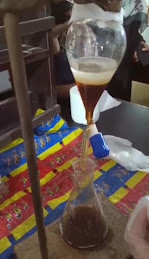Extraction
of Limonene from Orange Peel Using a Soxhlet Apparatus
Theory:
The extraction of limonene from orange
peel is a common procedure used to isolate this valuable compound for various
industrial and research applications. Limonene is a cyclic terpene hydrocarbon
found abundantly in the essential oils of citrus fruits, particularly in orange
peel. The Soxhlet extraction method is employed to separate limonene from the
peel using a non-polar solvent, typically hexane or petroleum ether. The
Soxhlet apparatus allows for efficient extraction by repeatedly boiling the
solvent, which vaporizes and then condenses, cycling through the solid material
multiple times. This continuous process maximizes the extraction efficiency,
ensuring a higher yield of limonene.
Chemicals
Required:
- Orange peels (dried and finely ground) - 50 g
- Hexane or petroleum ether (solvent) - 500 mL
Apparatus
Required:
- Soxhlet apparatus (consisting of a round-bottom flask, Soxhlet extractor, condenser, and a collection flask)
- Heating mantle
- Separatory funnel
- Glass wool
- Weighing balance
- Glassware
- Vacuum filtration setup
Procedure:
- Set up the Soxhlet apparatus by attaching the condenser, Soxhlet extractor, and round-bottom flask. Place a glass wool plug or filter paper in the extractor to prevent the solid material from entering the condenser.
- Weigh approximately 50 g of dried and finely ground orange peels.
- Add the orange peels into the Soxhlet extractor.
- Fill the round-bottom flask with 500 mL of hexane or petroleum ether.
- Assemble the Soxhlet apparatus and connect the condenser to a water source for cooling.
- Set up a heating mantle or hot plate/stirrer beneath the round-bottom flask and switch it on.
- Begin heating the flask gradually, allowing the solvent to boil and vaporize. As the solvent vapor rises, it condenses in the condenser and drips back into the Soxhlet extractor, cycling through the orange peels.
- Continue the extraction process for 6-8 hours to ensure a thorough extraction of limonene.
- After the extraction, disconnect the Soxhlet apparatus and remove the round-bottom flask containing the extracted solution.
- Transfer the extracted solution into a separatory funnel and allow the two phases to separate.
- Drain the lower aqueous layer and collect the upper organic layer (containing limonene) in a clean beaker.
- Perform a vacuum filtration to remove the solvent and concentrate the limonene.
- Calculate the yield of limonene by measuring the weight or volume of the collected limonene.
- Store the extracted limonene in a properly labeled and tightly sealed container for future use.
Observation:
Boiling
Point: 176-177°C (349-351°F) at atmospheric pressure.
Melting
Point: -74°C (-101°F).
Color:
Limonene is a colorless liquid.
Molar
Mass: 136.24 g/mol.
Molecular
Structure: Limonene has a molecular formula of C10H16,
indicating it consists of 10 carbon atoms and 16 hydrogen atoms. It is a cyclic
terpene and belongs to the class of monocyclic monoterpenes.
Calculations:
Let's assume the weight of the extracted
limonene is 2.5 grams, and the weight of the orange peels used is 50 grams. We
can now calculate the yield of limonene.
Yield of Limonene (%) = (Weight of
extracted limonene / Weight of orange peels) x 100
Yield of Limonene (%) = (2.5 g / 50 g) x
100
Yield of Limonene (%) = 0.05 x 100
Yield of Limonene (%) = 5%
Therefore, the yield of limonene from
the extraction process is 5%.
Precautions:
- Work in a well-ventilated area or under a fume hood due to the use of organic solvents.
- Handle the Soxhlet apparatus and hot glassware with caution to avoid burns.
- Ensure the apparatus is properly assembled and securely clamped to prevent accidents.
- Use heat-resistant gloves and eye protection during the experiment.
- Avoid inhaling vapors of the solvent. Keep away from open flames and sources of ignition.
- Dispose of waste materials and organic solvents properly according to local regulations.
.PNG)

.jpg)

.PNG)







.jpg)
.jpg)
.jpg)
.jpeg)




